Wild horses embody the spirit of the American West, and Wyoming is home to thousands of these majestic creatures. From safety tips to the best places to view mustangs, this is your guide to creating a memorable adventure in the Cowboy State.
Even a few minutes spent watching mustangs is a rare and awe-inspiring experience, and Wyoming’s grand landscapes make these encounters even more thrilling. The Bureau of Land Management’s (BLM) Wyoming offices look after 16 herd management areas on nearly five million acres, offering a number of opportunities to view wild horses. For the safety of both people and mustangs, it is important to be respectful when visiting — and to remember that wild equines behave differently than domesticated horses. These are six tips for viewing Wyoming’s wild horses, plus details on the locations where you are most likely to see them.
- Plan ahead and prepare– Wyoming’s mustangs tend to inhabit remote areas, so be sure to check road conditions and weather ahead of your visit. High clearance 4×4 vehicles are recommended on gravel roads, dirt roads and two-track trails, and many of these routes are impassable when wet. Visitors are advised to travel with a full tank of gas and carry a spare tire, and bring recovery gear like traction boards and an air compressor. Additionally, consider bringing extra clothing, water, food, a first aid kit and a satellite communication device, like a Garmin InReach, as cell signal is either limited or nonexistent in many of these locations.
- Maintain a distance of 300 feet from wild horses– As a general rule, the Bureau of Land Management recommends maintaining a distance of 300 feet from wild horses; this is especially important for wild horses with foals (offspring). However, this number can vary depending on the herd management area, so please check with the local BLM office before visiting. If a wild horse begins approaching you, slowly retreat and increase the distance between you and the animal.
- Do not touch or feed horses– Inappropriate and unlawful interaction with wild horses can cause them to become habituated, which means they can lose their fear of humans and vehicles, view humans as a food source, and behave more aggressively towards humans and one another. In some cases, this can also cause wild horses to abandon their foals. Check out the Wyoming Responsibly page for more tips on respecting nature during your visit.
- Do not engage in activity that interrupts or alters the horses’ natural behavior– Please do not yell, chase or otherwise provoke wild horses, and be mindful of how they behave in your presence. For example, is a horse peacefully grazing and otherwise ignoring you, or are they flattening their ears, snorting and pawing in your direction? This is the difference between a relaxed animal, and one that is about to charge you. When threatened, wild horses are known to charge, bite and kick.
- Dogs should be leashed or under strict voice control– Not only can an out-of-control dog spook horses, but one swift kick from a mustang can gravely injure or even kill your canine companion.
- Stay on designated roads and drive safely– Please remember to stay on established routes to preserve the habitat in the wild horse ranges and herd management areas. If you are pulling off the road to observe or photograph mustangs, find a spot that is not blocking other vehicles, and try to find pullouts with ample space. It’s also important to observe the speed limit, as wild horses and other wildlife frequently travel on the same roads as us.
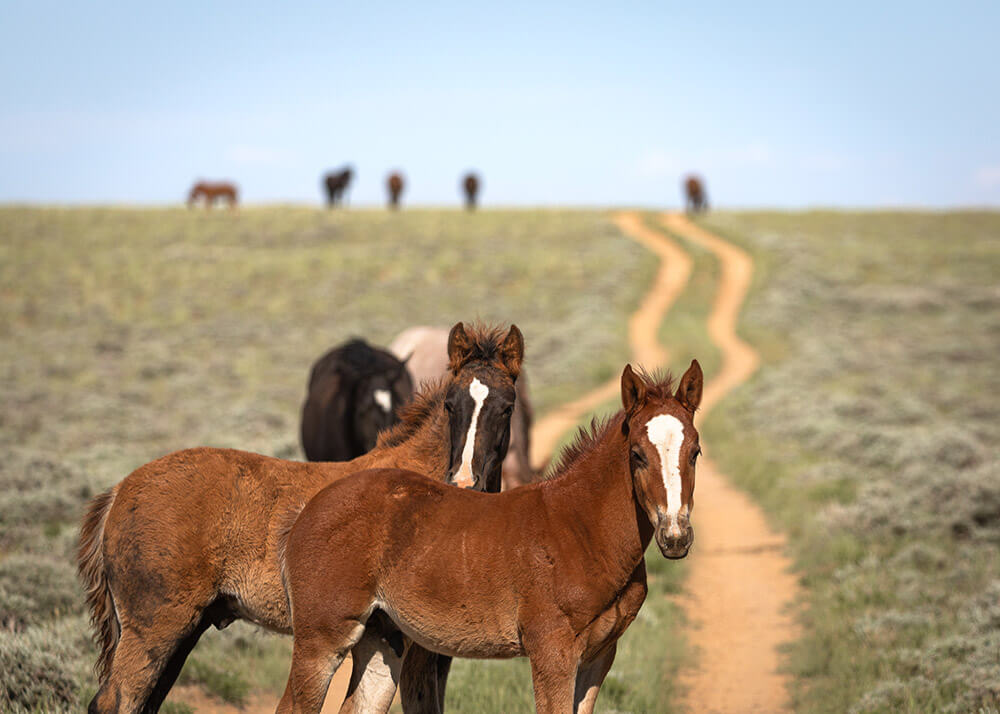
Horses often use the roads in more remote areas, so please observe speed limits and give them plenty of space. Photo courtesy of Elisabeth Brentano.
Pilot Butte Wild Horse Scenic Loop (Green River, Wyoming)
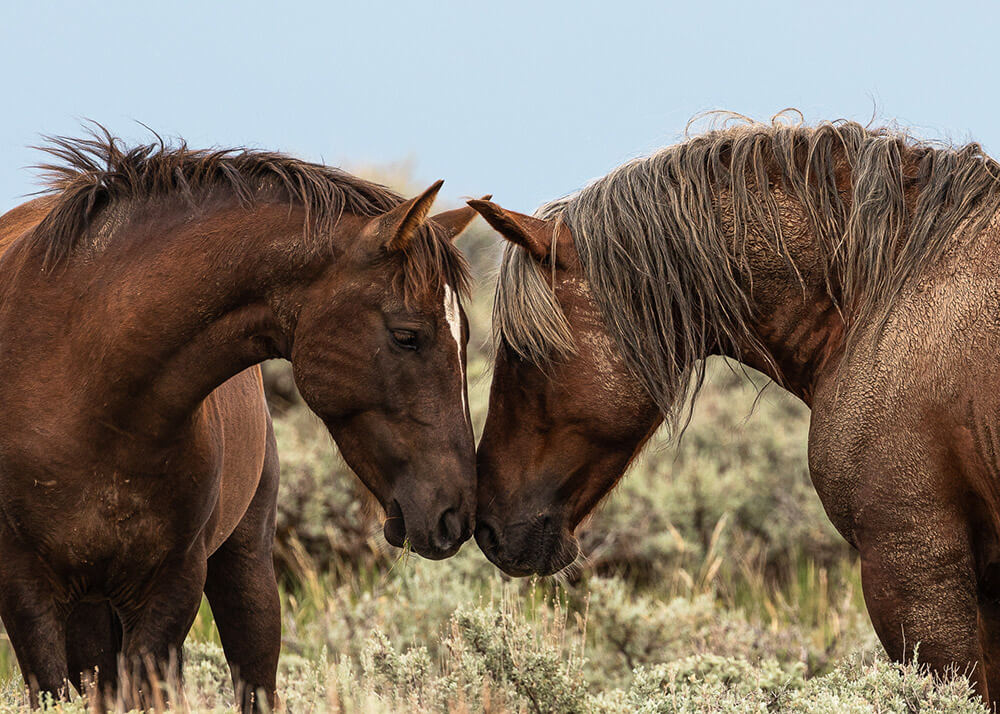
A pair of stallions size each other up before engaging in a mock sparring. Photo courtesy of Elisabeth Brentano.
VISITOR BASICS
The Pilot Butte Wild Horse Scenic Loop (aka County Road 53) is a 24-mile gravel and dirt road that runs through the White Mountain Herd Management Area, north of the cities of Green River and Rock Springs, Wyoming. The road is maintained from May to October, and though not required, a high clearance 4×4 vehicle is recommended. While the easternmost section by Green River is suitable for sedans, the road is impassable when wet, and it has a number of prairie dog holes and sharp rocks on the west end, so drivers are advised to use caution. There are a handful of two-track roads that split off from County Road 53 that may provide opportunities to see the mustangs, but these roads are not maintained, and a high-clearance 4×4 vehicle is required.
ABOUT THE HORSES
The White Mountain Herd Management Area spans more than 393,000 acres, and the population is estimated to be around 500 horses. It is believed that descendants of the horses were introduced to the area in the 1800s by cattle ranchers, and the horses are most closely related to North American gaited breeds like the Rocky Mountain Horse, the American Saddlebred, the Standardbred and the Morgan. A full range of colors can be observed here, including roan (both blue and strawberry), piebald, sorrel, gray, black, bay and chestnut.
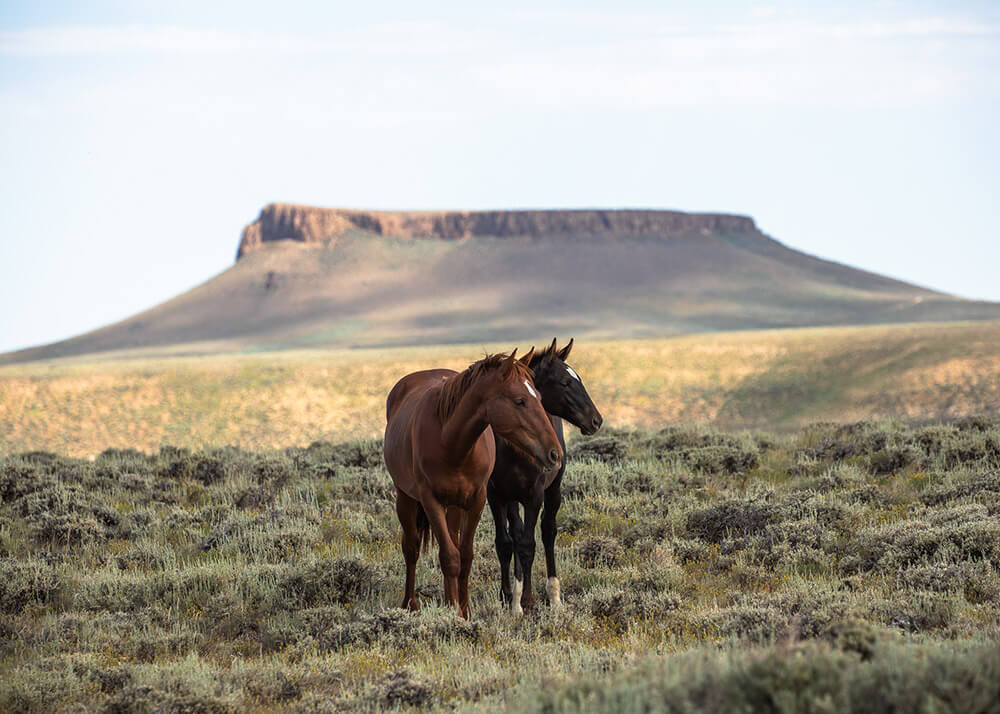
A pair of mustangs with Pilot Butte in the background. Photo courtesy of Elisabeth Brentano.
LOCAL LODGING AND DINING OPTIONS
Between Rock Springs and Green River, there are a number of hotel options, ranging from the Best Western Outlaw Inn to the Hampton Inn in Green River, the latter of which is located at the base of the Pilot Butte Wild Horse Scenic Loop. The Sweetwater Events Complex in Rock Springs has over 1,200 RV spaces among three campgrounds, nearly all of which have full hookups. Nell’s Coffee has a wide selection of coffee and espresso, plus their famous strawberry rolls, and Rock Springs is also home to Jack’s Crepes, which serves crepes, salads, pasta and paninis. For a more upscale dining option, consider Eve’s, which has a simple yet sophisticated dinner menu, plus Sunday brunch and burger nights. In Green River, Gudino’s Cafe is a local favorite, along with the Hitching Post Restaurant & Saloon.
Pryor Mountain Wild Horse Range (Lovell, Wyoming)
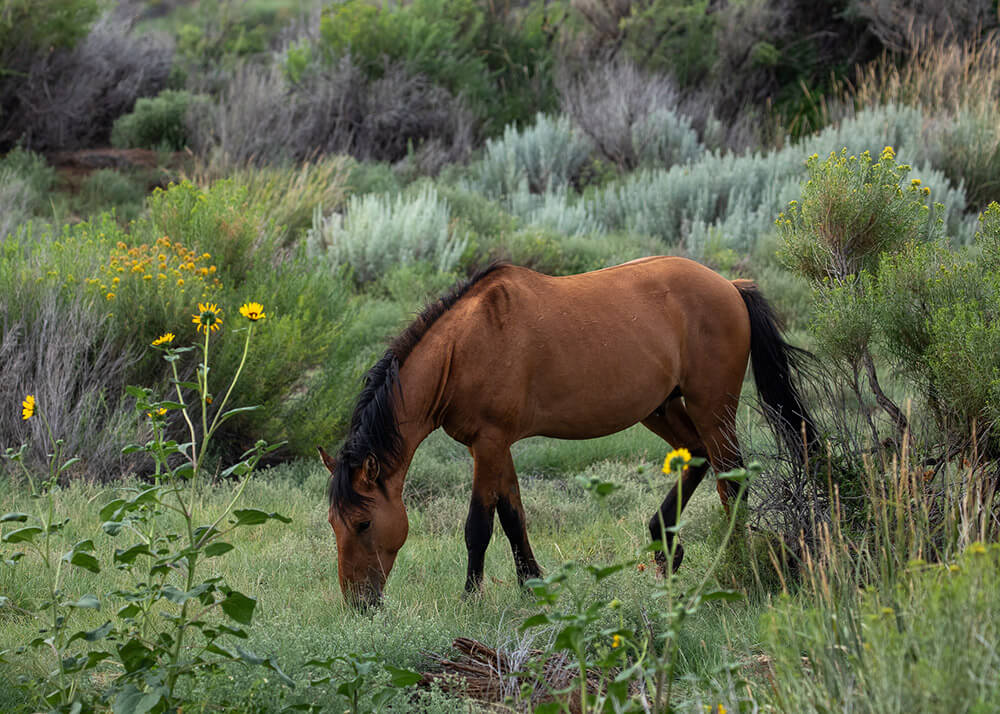
A young stallion grazing among the sage and sunflowers, near Highway 37 just outside of Lovell, Wyoming. Photo courtesy of Elisabeth Brentano.
VISITOR BASICS
The Pryor Mountain Wild Horse Range sits northwest of Highway 14A in Lovell, Wyoming, close to the state’s border with Montana. The Pryor Mountain Wild Mustang Center, located in Lovell, is an excellent resource for visitors, offering everything from maps to daily updates on where the horses have been spotted. The easiest option for viewing mustangs is via Wyoming Highway 37, a paved road with pull outs that runs north to south through the wild horse range and Bighorn Canyon National Recreation Area. Other access points include Sykes Ridge and Burnt Timber Ridge, but these steep, narrow roads are not maintained regularly, and a high-clearance, 4×4 vehicle is required. Guided expeditions to explore the more remote areas can be booked with PryorWild Tours. The tours cost $240 per person, and they depart from the Pryor Mountain Wild Mustang Center at 9 a.m.
ABOUT THE HORSES
The Pryor Mountain Wild Horse Range is one of four designated wild horse and burro ranges in the U.S., and it now spans more than 38,000 acres with a population of approximately 140 mustangs. Genetic tests have concluded that the Pryor Mountain mustangs have a higher-than-average level of Spanish ancestry in their DNA, and many of the horses have dun or grullo coats with dorsal stripes, which are striking and unique. The mustangs have been in the Pryor Mountains since the late 1800s, though some people believe they may have inhabited the region as early as the mid-1700s.
The Pryor Mountain Wild Mustang Center is open Monday through Saturday from 9 a.m. to 4 p.m., and Sunday from 10 a.m. to 2 p.m., Memorial Day through the end of September. In October, the Mustang Center is open Monday through Saturday from 9 a.m. to noon, and Sunday from 10 a.m. to 2 p.m. Winter hours begin in November, and the Mustang Center is open Saturday and Sunday only from 9 a.m. to noon. For more info, please visit the Pryor Mountain Wild Mustang Center website or call them at (307) 548-9453.
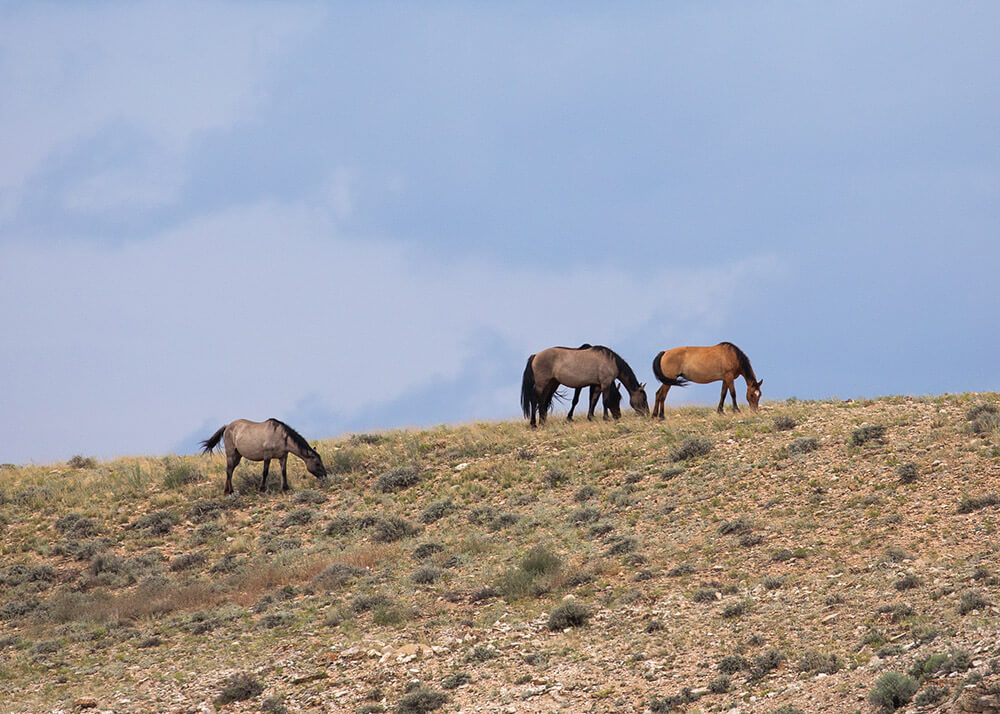
A small band of mustangs in the Pryor Mountain Wild Horse Range, including two with the distinctive grullo coloring. Photo courtesy of Elisabeth Brentano.
LOCAL LODGING AND DINING OPTIONS
The Horseshoe Bend Motel is the number one pick for lodging in Lovell, and the top-rated restaurants include Mustang Cafe & BBQ and the Shoshone Bar & Grill. Another worthy stop is Mustang Mountain Vineyard, which is home to a charming tasting room serving locally-produced wines. This venue is also a Harvest Host participant, offering three reservable RV sites for campers who are a part of the program. Horseshoe Bend Campground, which has 68 sites on two different loops, is located just 14 miles north of town on Highway 37, in Bighorn Canyon National Recreation Area.
Wind River Wild Horse Sanctuary (Lander, Wyoming)
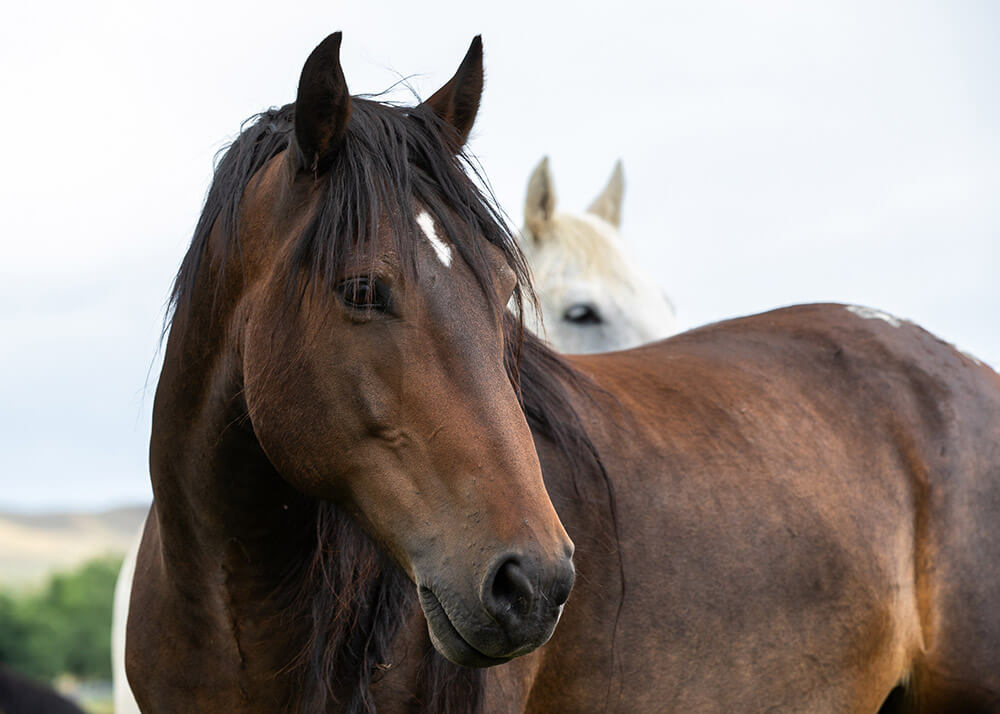
One of the 250 resident mustangs at the Wind River Wild Horse Sanctuary strikes a pose. Photo courtesy of Elisabeth Brentano.
VISITOR BASICS
Located on the Double D Ranch just eight miles outside of Lander, Wyoming, the Wind River Wild Horse Sanctuary is one of four public off-range pastures in the United States, managed in partnership with the BLM. Run by the Oldham family on their 1,400-acre working cattle ranch, the sanctuary offers a verdant, free-roaming environment for nearly 250 unadoptable mustangs. This is the country’s only public off-range pasture on tribal land, and the Oldhams pay homage to their heritage and traditions by educating visitors about the Native American culture’s deep appreciation of the horse. In addition to private tours, the on-site visitor center has displays covering the history and evolution of mustangs in the western U.S., along with a film screening area and a gift shop. The sanctuary also has a number of mustangs available for adoption, pending application approval through the BLM. (For more info on adopting wild horses, please visit the main BLM website.)
ABOUT THE SANCTUARY AND HORSES
The Oldham family’s passion for horses is evident from the moment you arrive at the sanctuary, and booking a private tour is a must for horse lovers. After I hopped aboard an ATV with Jess Oldham and his father Dwayne, I was thrilled to see dozens of mustangs peacefully grazing and romping around the lush pastures. While the mustangs at the sanctuary are more habituated to people than those on the open range, they still roam about just as they would in the wild, with minimal interference from humans. A few curious horses approached the vehicle, making for incredible photographic opportunities. From learning more about the adoption process to getting up close and personal with some of the resident mustangs, my afternoon at the Wind River Horse Sanctuary was nothing short of magical, and I can’t speak highly enough of this establishment.
The Wind River Wild Horse Sanctuary is open Monday through Saturday from 9 a.m. to 4 p.m. during the summer, and by appointment only in the winter. Tours are reserved by appointment only; the cost is $45 for adults, $20 for children aged 13-17, and children aged 12 and under are free. Photography tours and large group tours are also available upon request. For more info, please visit the Wind River Wild Horse Sanctuary website.
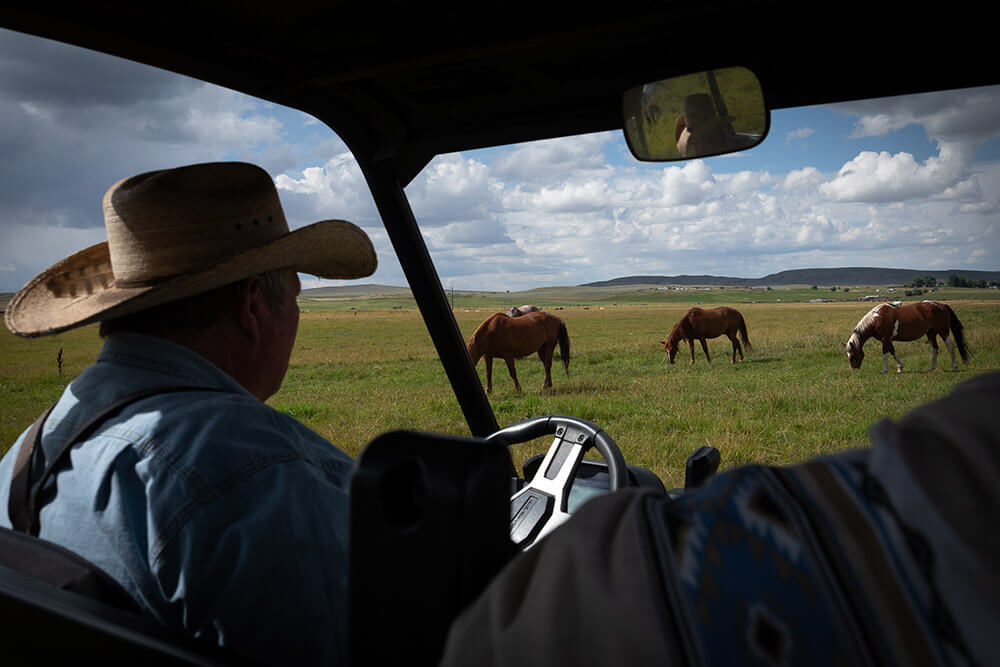
During a private tour, Dwayne Oldham pauses by a group of resident mustangs at the Wind River Wild Horse Sanctuary. Photo courtesy of Elisabeth Brentano.
LOCAL LODGING AND DINING OPTIONS
Lander has several top-rated hotels, including the Lander Motel, Mill House, and the Frontier Lodge. The Sleeping Bear RV Park & Campground offers sites with hookups, along with access to their showers for $8. Just eight miles southwest of Lander, Sinks Canyon State Park has two campgrounds, and several U.S. Forest campgrounds are located farther up Highway 131 above Sinks Canyon, with both developed and dispersed camping options. Some of the best restaurants in town include The Middle Fork, The Breadboard, Gannett Grill, Mulino Bistro and Cowfish. In addition to a full range of coffee and espresso drinks, Crux Coffee has tasty bites for breakfast and lunch, including pastries and sandwiches.
McCullough Peaks Wild Horse Herd Management Area (Cody, Wyoming)
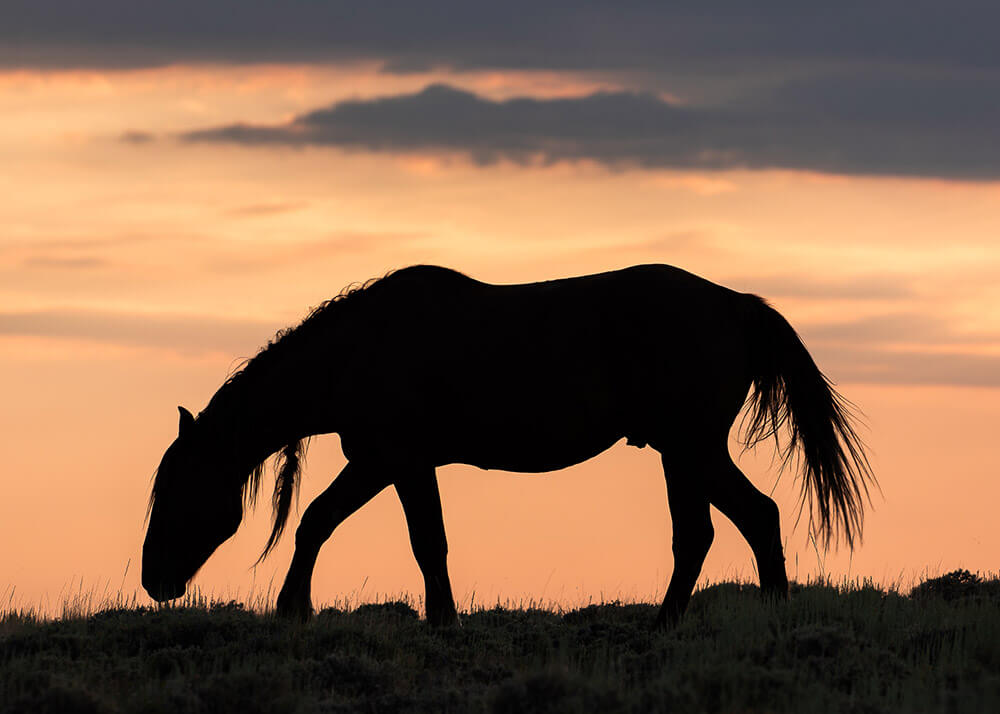
A band stallion meandering through the sage at sunset. Photo courtesy of Elisabeth Brentano.
VISITOR BASICS
The McCullough Peaks Wild Horse Herd Management Area is approximately 20 miles east of Cody, making it the perfect stop on a road trip through northern Wyoming. Whistle Creek Road (aka BLM Road #1213) runs through the herd management area, offering opportunities to view the mustangs among rolling hills and badlands. After driving approximately six miles, you’ll reach pipeline marker 75, which is where most vehicles turn around. Whistle Creek Road is a mix of gravel and graded dirt, and it is not recommended for low-clearance vehicles. Like Pilot Butte, there are two-track roads that split from Whistle Creek, but they are not maintained, and a high-clearance 4×4 vehicle is required. Half-day guided tours are also available via local outfitters including Cody Wyoming Adventures and Cody Wild Mustang Tours.
ABOUT THE HORSES
The McCullough Peaks Wild Horse Herd Management Area covers over 120,000 acres, and the current population is estimated to be around 180 horses. The McCullough Peaks mustangs are believed to be descendants of Buffalo Bill’s horses from his Wild West Show, and you’ll see a range of coat colors, including piebald, roan, sorrel, buckskin and palomino.
LOCAL LODGING AND DINING OPTIONS
Cody is home to a handful of hotels, including the Scout Inn, the Cody Hotel and the Irma Hotel. Located right in town, the Ponderosa Campground & RV Park has cabins, tent sites and 140 full hookup RV sites. Nearby Buffalo Bill State Park has two campgrounds with nearly 100 sites total, all of which can be booked online. Some of the top restaurants in Cody include 8th Street at The Ivy, Cody Steakhouse and Fat Racks BBQ. Beta Coffeehouse has the best lattes in town, and if you’re craving a crepe, stop by The Station for sweet and savory options, plus smoothies and coffee.